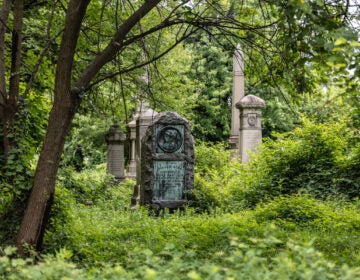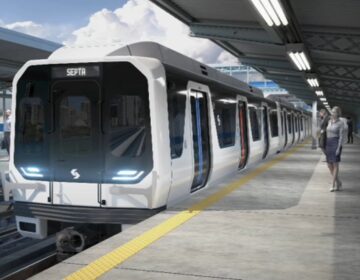Best Practice: The City
Feb. 4
By Matt Blanchard
For PlanPhilly
Can other cities help Philadelphia reclaim its waterfront?
The answer, according to the second panel discussion of the Best Practice session, is a resounding yes. The keys to successful waterfront development are neither mysterious nor secret, as cities all over the world have been reclaiming their rivers for the last 30 years.
Three experts, Alex Krieger, Antonio Di Mambro and W. Thomas Lavash, outlined these best practices of waterfront planning. They agreed that if Philadelphia moves ahead quickly and cautiously, with an ambitious, long-term planning strategy, the signal success of waterfronts like Vancouver and Manhattan can be realized here.
Alex Krieger
Alex Krieger is professor of practice in urban design at Harvard’s Graduate School of Design, and a founding principal of the firm Chan Krieger & Associates. His presentation at the Best Practices session was a whirlwind tour of success stories in Boston, Pittsburgh, Cincinnati, Louisville, Chattanooga, Vancouver and Washington, D.C.
From each city, Krieger drew out the essential lesson. But first, he urged Philadelphia to get off its duff.
“Many of these cities are much smaller than you are, so you should all be ashamed of yourselves,” Krieger joked.
In Boston, Krieger said downtown redevelopment had been governed by a four-point formula.
1) Save as many historic structures as you can.
2) Introduce housing as close to the water as possible. More than office, retail, or entertainment uses, housing brings sustained life to the waterfront.
3) Introduce well-designed open spaces
4) Introduce recreation facilities to bring residents in contact with the water.
Krieger then expanded the formula with six more points, here paraphrased:
5) Cities everywhere are creating continuous public access: running and biking trails that extend for miles and link neighborhoods.
6) Don’t forget perpendicular approaches to the water, those cross-streets and vistas connecting the city to the water’s edge.
7) Promote living on the water. “It is people living on or near the waterfront that make it lively and increase value,” he said.
8) Accommodate civic amenities from ice rinks to water parks.
9) Facilitate public-private cooperation.
10) Plan long term. The Delaware is your long-term value, not a way to turn a quick profit.
In Pittsburgh, the Three Rivers Master Plan transformed the waterfront in a city more cash-strapped than Philly. The plan included housing on the river, continuous public access to the water’s edge, and a system of ferries carrying passengers up and down the rivers, from parking locations on the outskirts to a sports stadium and other downtown amenities.
In Cincinnati, the city couldn’t get rid of their waterfront highway, but instead managed to extend five streets over it to reconnect the city fabric to the river.
In Louisville, Kentucky, the city coped with an elevated highway much like our I-95. Instead of burying the highway, planners lowered the ground plain, so the green lawns of the park slide right under the highway.
In Chattanooga, the city reclaimed industrial land for a strip of lively waterfront parks, linking the river to downtown streets with a grand stairwell. As in Chattanooga, waterfront parks “don’t have to take billions of dollars,” Krieger said. “But they do have to be beautifully conceived, and beautifully designed.”
In Vancouver, the city motto is “Living First.” Krieger said the city’s vaunted waterfront neighborhoods are among the nicest in North America because they focused on housing; high-rises, low-rises, and town homes form a lively mix. “They invested big in housing on their waterfront,” Krieger said. “The result is an amazing array of places to live.”
In Washington, D.C., the city mastered its beautiful connection to the Potomac. Now it is launching a renovation of its other riverfront, the industrial and poor residential neighborhoods along the Anacostia River. Very much in keeping with Krieger’s principles, the Anacostia Waterfront Initiative aims to create a continuous public corridor along the water’s edge, add about 30,000 housing units at sites along the river, and create public spaces of distinction.
In conclusion, Krieger urged Philadelphians not to get locked in conflict over competing uses for the waterfront. It is the job of wise planning, he said, to “unravel unnecessarily polarized visions.” So long as certain principles are followed, Krieger told the assembled citizens that “many things can and should take place on the waterfront, just as they always have.”
Krieger also reminded the audience that Philadelphia is no stranger to master planning. The interlocking complex of the Ben Franklin Parkway, the Art Museum, the Fairmount Waterworks and Kelly Drive form a brilliant riverfront treatment, many decades in the making.
“You have your own version of these plans in your history. You know how to do this. You know how long it takes,” he said. “Therefore, you’ve got to get going.”
Antonio Di Mambro
Italian-born architect Antonio Di Mambro showed how other cities have tackled the obstacles of infrastructure – particularly those large-scale urban features such as highways that form barriers between neighborhoods and the water. Philadelphia certainly has one such a barrier in Interstate 95.
But while others at the conference spoke of small interventions, Di Mambro thought on the grand scale.
Success, he said, requires careful study of the entire region’s form and infrastructure – the arteries and organs that keep the urban system alive. It may also require truckloads of money and plenty of time.
“All the cities around the world have rediscovered the magic along the water’s edge,” Di Mambro said. “They did it by transformative infrastructure investments… All of these investments required 15 to 30 years for planning and execution… Don’t just look at I-95. Look at the entire region.”
Di Mambro, a principal in his Boston-based firm, is an urban designer with expertise in large-scale projects, massive urban interventions on the scale of Boston’s Big Dig.
His lecture began in the Italian city of Mestre, across the bay from Venice, where a vast swath of industrial land along the coast awaited some spark to bring it back to life. The city made a strategic investment by building Parco San Giuliano, a vast greenspace along the coast. Beyond the park itself, the project entailed sea gates to control flooding and the building of a new subway line. But the gamble paid off, Di Mambro said. “Parco San Giuliano became a catalyst for redevelopment of the whole industrial area.”
Moving on to Boston, Di Mambre set out to correct mistaken assumptions about the city’s much-publicized Big Dig, a multi-billion effort to bury the elevated Central Artery highway and resuscitate the downtown.
“The real story of the project is not the Big Dig,” he said. The Big Dig was only one facet of an initial $26 billion regional investment strategy that modernized Logan Airport, connected the airport to the Massachusetts Turnpike, cleaned up Boston Harbor, and rebuilt the mass transit system.
Blessed with powerful politicians, Speaker of the House Tip O’Neil and Gov. Michael Dukakis, Boston was able to swing federal funding to attack the city’s problems on several fronts at once, making infrastructure investments designed to foster economic growth.
“We are very proud of what happened here,” Di Mambro said. He’s also proud of what Boston is planning next: A circumferential transit line, selling air rights for building over the turnpike and the building of a new neighborhood on Chelsea Creek.
For Philadelphia, a comparative dawdler, Di Mambro had strong advice: Think big, be bold and start fighting for federal funding now.
“Think about Philadelphia in 2040. Not next year, and not ten years from now.” he said. “Ask yourself: What does Philadelphia need to have to be a world class city by 2040. Whatever it is, make the project and get it in the pipeline for funding.”
With the federal SAFETEA act is up for reauthorization in 2010, Di Mambro suggested Philadelphia look to building a coalition of 30 or more cities to expand the pool of federal money available for urban infrastructure.
“Build the coalition that will make the funding possible,” he said.
W. Thomas Lavash
Into a discussion of big dreams for the waterfront, Tom Lavash brought a sobering message: Unless your plans are profitable, they won’t get built.
Lavash, of Economic Research Associates, is a real estate finance advisor who tries to bridge the gap between public sector governments and the private sector developers on whose participation the success of Philadelphia’s waterfront will depend.
If architects like to say “form follows function,” developers know that “form follows finance,” he said. And any city planning major projects should pay heed.
While citizens see a riverfront ripe for new homes, shops, and offices, Lavash sees a market with problems. “In Philadelphia you face significant challenges,” he said, for both housing development and office and industrial development.
The major drivers of housing development in any region are population growth, new household formation and immigration. Philadelphia lost 500,000 people since 1970, Lavash said, “a huge red flag in our industry.”
The major driver of office and industrial development is job growth, Lavash said, and on this score, too, Philadelphia is limping, having lost 269,000 jobs in the last 30 years.
At the same time, the competition for federal and state funding is intense. “Every city in the nation is going after the same pool of public funding,” he said.
These challenges are not cause for despair, Lavash suggested, but rather a call for careful planning.
The city should be ready to offer development incentives to bring developers on board. Such incentives include an extra height allowance and a higher floor area ratio, allowing for bulkier structures. Planners should also peg development approvals to the creation of public assets.
The city must also be mindful of its entire economy. For example, Lavash saw a silver lining in the much-maligned placement of a Home Depot and a Wal-mart on the south Delaware waterfront. “Home Depot may not be the best use, but at least it stemmed the bleed of your retail to the suburbs,” he said, which would drain the city’s tax base.
As it moves forward, the city should protect viable existing industries, for example doing nothing to hamper the Port of Philadelphia in its effort to grow new shipping business, and everything to help. Every facet of the city’s economy is in some way connected.
Also, every effort should be made to use public money as a lever to stimulate private investment. Lavash said the average leverage ratio Philadelphia should shoot for is $12 of private money for every $1 of public money. The city of Providence, RI, for instance, spent $100 million on uncovering and enhancing its downtown river, and in turn generated $1.5 billion in private investment.
Philadelphia’s position is not ideal, Lavash said, but the dividends of success are potentially enormous.
Audience Questions
For discussion of questions from the audience, the three national experts were joined by three local experts: Alan Greenberger of the Design Advocacy Group, Rina Cutler of the PA Department of Transportation, and Michael Larice of PennDesign. The major issue emerging from the discussion was where, exactly, should redevelopment begin? In Center City? In Kensington?
(Note: Questions and responses are not exact quotations, and may omit points made by the speaker)
Q: How do we balance these great visions with funding, and with the need to provide highway service for casinos and other new developments?
Rina Culter of PennDot: Ah to be a planner, rather than an implementer. Before I came to Philly, I was transportation coordinator for the Boston project. It was a 30-year, $40 billion project and every step of the way was fraught with issues. The remainder of the infrastructure continues to struggle for money. I do not believe we are ready to contemplate putting I-95 underground. We’re more likely to look at a plan for something under I-95, and for decking depressed portions.
Q: How can we push the policymakers to support ideas for a livable waterfront?
Alan Greenberg of DAG: “We as a community have to push hard for comprehensive thinking about this. And as for dealing with I-95, we may need to think not in terms of big solutions, but small solutions. I’d like to make an analogy to acupuncture, which seeks to release flows of energy by the insertion of a very small needle. I suggest to you all that the city, too, is full of energy flows. Center City is a massive success, but that energy is clearly not going to the waterfront. So how does the city’s energy get channeled to the waterfront? We’ve got to find those critical points where the insertion of the needle will release the flow. Small, targeted interventions may not require the massive investments of Boston’s Big Dig and the like.
Q: So, where do we “insert the needle” to energize the waterfront?
Antonio Di Mambro: You’ve got to go south and really tackle your port in a serious way. Romantic views about the port will not help. Everything is changing, globally, and there’s much to be done. In the downtown, either you bite the bullet or you leave it until later. Sixteen lanes of I-95 is a nightmare. You’re not going to solve the problem by decking the highway alone. You’re going to need big money. You’re all scared of asking for money, and I don’t know why. Your country is spending so much money to tackle the terrorist guys, and you’re scared to ask for money for your own back yard. (applause)
Alex Krieger: You can’t start in Center City. I-95 is too humongous a problem. Get all that housing on the north side done. Get your big box retailers fixed up in the south. Work on the extremities, and one fine day you’ll be ready to tackle I-95.
Q: How do we pay for the big vision? What should our first steps be?
Thomas Lavash: The seven miles of the riverfront is too a long geography to do everything at once. We really need to prioritize and decide among the stakeholders – including the investment community – which sites will build momentum for the entire area. We also need a companion effort by the city’s economic development team to attract investment. The economic development game will inform the choice of priority sites.
Antonio Di Mambro: You in Philadelphia cannot be waiting for Godot. If you don’t have a project, you can’t ask for federal funding and you’ll end up with nothing. If you get a good piece of a project, you can write an RFP and then do something with the private sector. But it is critical to have a project in the works, something that can win funding.
Q: Regarding casinos, can new neighborhoods be located adjacent to a casino on the Delaware?
Alex Krieger: In seven miles, you can do a lot, including potentially a casino. One should not argue about this in a binary system of yes/no. It’s not a zero-sum game. The Delaware River can accommodate many things. It’s the design of things that matters. Any casino must be carefully designed, and there can be no junk space around them. There is a particularly well-integrated casino in New Orleans’ French Quarter that comes to mind. You can accommodate a casino, but you’ve got to be vigilant about what occurs after its development.
WHYY is your source for fact-based, in-depth journalism and information. As a nonprofit organization, we rely on financial support from readers like you. Please give today.






